Menu
Coal production: More coal despite the climate crisis: production at its highest level
Categories
Most Read
Seal windows: How to minimize heat loss
October 21, 2025
No Comments
Climate: Environmental organization warns about China’s coal chemical projects
October 21, 2025
No Comments
Former kitchen manufacturer: Trial against ex-board members discontinued after Alno bankruptcy
October 21, 2025
No Comments
Dust off radiators: This is how you save money in winter
October 21, 2025
No Comments
Economic situation: Allianz subsidiary: company insolvencies will increase worldwide in 2026
October 21, 2025
No Comments
Latest Posts

Power supply: Electricity prices too high in winter? Authorities submit report
October 21, 2025
No Comments
Power supply Electricity prices too high in winter? Authorities submit report Copy the current link Add to watchlist At the end of 2024, electricity prices

Champions League: “A stroke of luck” Kompany and a Belgium duel with history
October 21, 2025
No Comments
PierceI am Pierce Boyd, a driven and ambitious professional working in the news industry. I have been writing for 24 Hours Worlds for over five

“Flied through the vehicle” – These 3 child seats failed the ÖAMTC test
October 21, 2025
No Comments
Image: (Weihbold) The current results The mobility club tested 16 current models in the categories of safety, operation, ergonomics and pollutants. “Even though no product
24 Hours Worlds is a comprehensive source of instant world current affairs, offering up-to-the-minute coverage of breaking news and events from around the globe. With a team of experienced journalists and experts on hand 24/7.

